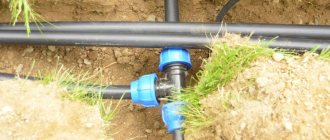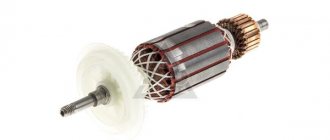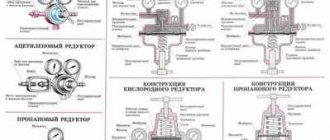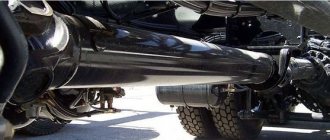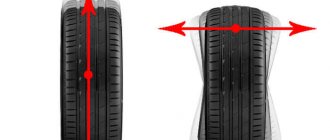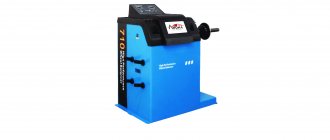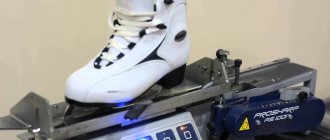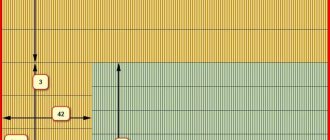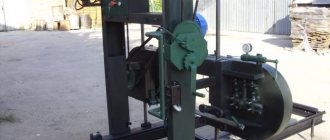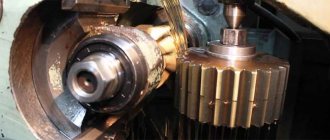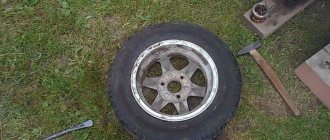Wheel balancing is the elimination of imbalance of a car wheel by shifting the center of rotating masses as close as possible to the axis of its rotation. The need for such a procedure arises when the mass of tires and wheels is displaced relative to their axis of rotation. Because the imbalance is transmitted to the car’s suspension elements.
Balancing the wheels on a car prevents excessive vibration of the steering wheel and body while driving, and also helps prevent deterioration in handling and premature wear of wheel bearings, ball joints and suspension silent blocks.
In this article we will talk in detail about when you need to balance wheels, how this procedure is carried out and whether you can do it yourself, as well as answer other frequently asked questions about wheel balancing.
Why do you need wheel balancing?
Wheel imbalance is a violation of the distribution of its mass relative to the horizontal or vertical axis. There are two types of imbalance.
- Dynamic - the intersection of the axis of rotation with the axis of inertia, disrupting the horizontal distribution of the wheel mass. In this case, while moving, the disk writes a figure eight.
- Static – displacement of the axis of rotation relative to the axis of inertia. Causing the center of gravity to move up and down.
Imbalance of the wheels while driving at speed worsens vehicle control, increases the braking distance, and accelerates the wear of chassis and tire parts. Constant vibration first of all causes the hub bearings to become unusable, and over time, the entire chassis system of the vehicle fails.
Attention! At a speed of 90-110 km per hour, an imbalance of just 20 g is equivalent to hitting the wheel with a hammer weighing 3 kilograms every 3 seconds.
Types of imbalance
Today there are two main types of wheel imbalance:
- Static imbalance. This implies an uneven distribution of the mass of the product along the axis; the wheel begins to “beat” in the vertical plane. In fact, there is no center of gravity on the wheel axle at all. This problem sooner or later leads to destruction of the suspension.
- Dynamic imbalance is unevenness in the plane of the wheel. In this case, there is a center of gravity, and it is on the axis of rotation (where it should be). The only difference is that the axis of inertia and the center of gravity do not coincide.
The cause of the imbalance may be the design features of the wheel (tread pattern, location of the valve hole, inaccuracies in geometry, dimensions, and so on).
In this case, the greatest imbalance can be caused by the car tire itself. Here, a lot depends on the rubber material, weight, structure, and so on.
How often to carry out
There are no universal recommendations on the frequency of balancing, since the need for this procedure depends on the condition of the rubber, operating conditions of the vehicle, and other factors. Practice shows that balancing is necessary in the following cases:
- when changing tires;
- after hitting a wheel with an object or falling into a deep hole at speed;
- every 15,000 km during quiet driving, every 8,000-9,000 km for fans of an aggressive driving style;
- before and after traveling distances of 1500 km.
Signs of poor quality work
Wheel balancing is not always done well. There are several factors by which this can be determined:
- The service station does not take any measurements before carrying out work. A good mechanic should definitely check the wheel and tire runout parameters. At the same time, it is advisable to do this as accurately as possible, taking into account radial and lateral runout;
- All dirt from the tire and excess elements from the tread must be removed. If this is not done, then balancing becomes a completely useless exercise. Before starting work, the wheel must be perfectly cleaned;
- Pay attention to the appearance of the balancing machine. If it is dirty, then it is very difficult to count on accurate data and high-quality balancing.
Signs of Imbalance
The conditions described in the previous paragraph of the article relate to planned balancing. But often drivers should carry out the procedure unscheduled if the following signs of imbalance in the wheels are observed:
- uneven tire wear;
- shocks to the steering wheel and its vibration - when the front wheels are unbalanced;
- Vibration of the rear seats - when the rear wheels are unbalanced.
Important! The car owner can eliminate exclusively static imbalance on his own. Dynamic imbalance can be corrected only with professional equipment!
What is the danger?
It would seem that what can happen if wheel balancing is not done in a timely manner? We often forget that each wheel has its own individual weight, pressure, technical characteristics, oval shape and defects. Therefore, the issue of balancing it is very important.
If this is not done, the consequences may be as follows.
The braking distance of the car increases.
This is easy to explain - the contact area between the tire and the asphalt decreases, grip deteriorates, and traffic safety decreases.
Controllability decreases.
The reasons are the same as in the previous case.
There is a beating in the steering wheel.
The imbalance in the wheel is transmitted to the suspension, and then to the steering wheel. The stronger it is, the greater the vibrations the driver feels. In this case, driving a car is very dangerous.
Suspension wear accelerates.
Poor balancing (or lack thereof) most affects the suspension bearings and hubs. Due to imbalance, these elements of the chassis system may even collapse. The result is loss of controllability and the likelihood of an accident.
Increased tire wear.
The reasons are uneven distribution of forces and the appearance of vibration. Essentially, the tires will be “eaten up” on one side.
How to carry out balancing at a service station
Tire workshops are equipped with specialized machines for wheel balancing. Structurally, the machine consists of a cone-shaped support on which a wheel is placed, a rotating motor and sensors. Based on the type of support, machines are divided into:
- soft, taking into account the vibrations of the supports when the wheel rotates;
- rigid, measuring pressure and rotor phase.
The balancing procedure on them is carried out simultaneously with the change of tires: the computer determines pressure and vibration and calculates the weight and location of the weights. On outdated models, the technician takes measurements manually and enters data for calculations. Modern machines read information automatically and display graphic and digital information on a computer monitor.
How to make a stand (machine) for balancing
Build a homemade product by first making a drawing of the device. Find the wheel hub in working condition, remove the boot from the bearing.
A do-it-yourself wheel balancing device is a metal structure consisting of a frame and vertical profile posts mounted on it.
Install the hub on the frame between the racks so that the ramp can rotate freely. Please note that dynamic balancing of wheels on a homemade machine is impossible: “eights” are eliminated at professional stands in car repair shops.
What you need to do your own balancing
To carry out the balancing procedure, you must prepare:
- set of wrenches;
- chalk or marker;
- set of balancing weights;
- hammer.
The main item for balancing is special weights weighing from 10 to 100 grams. For stamped discs, stamped models are used, for cast discs, self-adhesive ones are used. According to reviews from car owners, self-adhesive weights are not reliable in winter. Temperature changes and high humidity cause the glue to weaken and the weights simply fall off. However, the design of some models of alloy wheels does not allow the use of padded weights, so car owners have to use self-adhesive ones.
How is wheel balancing done?
Before you begin balancing, the wheel should be prepared. First, it is thoroughly cleaned, all old weights are removed, washed, and dried. Check that the tire is installed correctly. The wheel should be slightly lowered, the air pressure in it should not exceed 0.2–0.3 kgf/cm2.
At tire shops, balancing is carried out using special balancing stands or machines. But you can try to eliminate the imbalance at home without a stand, however, the accuracy of such a procedure will be much lower.
In order to eliminate the imbalance at home, you need to lift the car using a jack so that the wheel rotates freely. First it spins to the right. After stopping, a chalk mark is placed at the highest point. Then it spins to the left, the procedure is repeated. The distance between the marks must be divided in half and a new mark must be placed. After this, special weights with spring clamps are installed on both sides of the mark on the tires for balancing, which are mounted under the tire, while the weights are held on the wheel rim. Then the wheel is spun again by hand. If after stopping the weight occupies the lower position, then everything is fine, its weight is sufficient. If it ends up at the top, then you should replace it with a heavier one. By moving the weights to the same distance from the mark, it is necessary to ensure that after unwinding, each time the tire stops in a new position, chaotically. If this can be done, then the wheel is pumped up and you can start balancing the other one. The imbalance on the front wheels is corrected at their hubs. But the rear ones should be unscrewed and moved to one of the front hubs for balancing.
At service stations and tire shops, this procedure is carried out using special equipment. After all the preparatory procedures, the wheel is installed on a balancing machine with a fastening cone.
Correct wheel balancing, the most accurate, is done on a special computer stand. A wheel is installed on it and its parameters are set. After that, spinning it in different directions, using a computer, the lightest place and the missing weight are revealed. The car service specialist simply adds weights to the disc in the required places to eliminate the imbalance.
It is worth considering that the total weight of the installed weights should not exceed 60 grams. If their total weight is higher, it is worth thinking about whether the wheel is assembled correctly, whether the disk is deformed, or whether the tire is stale. If the tire is just from the store, and is installed correctly, there is no damage to the disk, then the need to attach weights with a total weight of more than 60 grams. indicates her marriage and may serve as a reason to return to the store.
Balancing methods
The technology for self-balancing is generally no different from the work of professional craftsmen. The only difference is determining the weight and installation location of the weights without electronic devices, “by eye.”
Without removing the wheels
To balance the wheel without removing it from the hub, the body on one side of the car is raised with a jack and secured with shoes or other available means. Then slightly loosen the hub nuts of the freed wheels. The balancing process consists of the following steps.
- Spin the wheel clockwise. After stopping, mark the top point.
- Spin the wheel counterclockwise and mark the top point again.
- The middle between the two marks is a light point onto which prepared weights weighing from 10 to 40 grams are placed. After rotation, the weights should be at the bottom. If this does not happen, increase the weight of the sinker.
- The next stage is static balancing. Gradually move the weights the same distance relative to the center point. The goal of this process is to ensure that the wheels end up in a different position each time they rotate. Once this has happened, static balance has been achieved.
Attention! The weights should not be piled up on each side of the disc. If they are located at a considerable distance from each other, it means that the balancing was carried out with errors.
At the stand
A homemade balancing stand is constructed from an old hub with a working bearing. The part is installed on a metal profile frame so that the mounted wheel rotates freely. Structurally, the stand consists of two vertical posts, between which a wheel is installed. The balancing process is carried out in the same way as described in the previous paragraph.
Balancing with granules
The newest balancing method is to use special granules (beads) instead of weights. In fact, the method was patented back in the 50s of the last century, but it was not widely used in passenger cars. The reason for this is the high cost of the beads themselves and their significant weight to achieve wheel balance.
Balancing granules are miniature ceramic or glass balls of regular shape, coated on top with a layer of silicone. The balls fall asleep inside the wheel, and they are distributed in its space under the influence of centrifugal force. The granules have an electrostatic property, so they “stick” to the tire and eliminate imbalance while driving.
The granule balancing technique has a number of advantages:
- Possibility of balancing once. According to the manufacturers, the beads are practically eternal and will work effectively for the entire period of operation of the wheel.
- Automatic self-balancing for any changes in the suspension system: dirt, tire wear, small disc defects.
- Ease of use.
However, the method also has some disadvantages:
- Displacement of granules when a wheel hits a hole. Repeated self-balancing occurs after some time. However, on an uneven road the wheel will be almost constantly in an unbalanced state, which negatively affects the suspension and controllability of the car.
- Large weight of granules required for high-quality balancing. Achieving the desired effect occurs after pouring 100 g into the wheel. granules, while for balance in a passenger car, 15 to 60 grams is quite enough. Therefore, manufacturers recommend using this technique on trucks and SUVs.
- The cost of a set of granules is equivalent to two sets of rubber, which significantly exceeds the price of traditional methods.
If a decision is made to use balancing granules, their quantity is determined according to a special table located on the packaging. The required weight depends on the wheel size. Balancing granules are poured into the tire cavity during its installation on the disk or tubes through a fitting. To place pellets directly into the wheel assembly chamber, the following steps are necessary:
- Jack up the car and deflate the tire.
- Unscrew the nipple from the camera and place a plastic tube on the fitting.
- Pour the required amount of granules into a plastic sauce bottle.
- Place the end of the plastic tube over the hole in the bottle cap.
- Turn the bottle over and pour the granules into the wheel.
- Inflate the tire to the desired pressure and you are ready to hit the road.
Important! Balancing by any method is carried out after removing dirt, pebbles and old weights stuck in the treads from the wheel. If wheel covers are installed, they must be removed.
How to balance a set of tires at home?
DIY balancing device
If a tire service is unavailable or if you want to save money, you can balance the wheels yourself using a machine that can be assembled in a garage. The simplest garage balancing stand consists of a hub securely mounted on a rigid support with a flat base.
Balancing must be done in the following order:
- Fasten the wheel, cleaned of dirt, to the hub and spin it by hand.
- During rotation, observe the beating of the rubber, the “figure eight” of the disk.
If there are strong pronounced deformations and runout, balancing is unlikely to help. - Wait until the wheel stops and is balanced, put a chalk mark at the top point.
- Turn the wheel 90 degrees (a quarter turn) in both directions several times, waiting for it to stop after each turn.
- If the wheel is in a different position each time, there is no pronounced static imbalance, it is “conditionally balanced.”
- If the mark is always at the top, the main point of imbalance has been identified, you can begin to eliminate it.
The faster the wheel returns to the top position, the more weight is needed. Its exact value can only be predicted experimentally. Without experience, you can start with a load weighing 20–30 grams. - To eliminate the imbalance, you need to hang (without fixing it securely) a weight opposite the mark and repeat step 4.
- If, after hanging the weight, the mark still appears at the top, its mass must be increased; if it now goes down, it must be reduced.
- It is necessary to adjust the weight of the weights until the wheel, after spinning 90 degrees, stops in any position. When the optimal set of weights has been selected, they can be fixed.
For a more uniform distribution of masses, you can use several weights: for example, instead of one for 40 grams on the outer side, attach 20 gram weights on the outer and inner sides opposite the mark.
The described method is a static balancing designed to shift the center of mass of the wheel as close as possible to the axis of its rotation. It allows you to eliminate very large imbalances with an accuracy acceptable for cars that do not drive fast, but is not suitable for fine adjustments of balance. This is acceptable wheel balancing for VAZ classics and other similar models.
More accurate balancing of car wheels at home is possible using a “spinning top” shaped device. The tool can be made on a lathe from a solid steel blank (moreover, steel is harder than the common ST-3) with a diameter of about 150 mm, so that the structure is monolithic and balanced.
Aluminum and other soft metals are not suitable because the ends of the spindle axle must be rigid and not deform or become dull under the weight of the wheel!
The tool should have a slight taper on one side that turns into a thread. The conical shape is needed so that the wheel self-centers when the nut is tightened.
The balancing process is carried out as follows:
Balancing a wheel at home: video
- Place the “top” in the central hole of the disk and tighten it with a nut.
- Place the wheel with the tip of the “top” on a flat, hard surface or in a stand with a recess.
- Move the wheel and release it, controlling the position in space. A balanced wheel should independently occupy a horizontal position and return to it after rocking. If there is an imbalance, it will not stay “in the horizon”.
- If an imbalance is detected, you need to take a weight and place it at the highest point of the wheel, and then repeat step 3. If the same section still rises with the load, its mass must be increased; if it begins to fall, decrease it.
- The weight of the weights is selected until the wheel on the spoke begins to take a horizontal position and returns to it after each rocking. The static balancing of the wheel is completed, and if high accuracy is not required, then it can be placed on the car. If you also need to eliminate dynamic imbalance, then you need a rigid tripod (for example, a laboratory one) with chalk and the following further actions:
- The wheel is manually spun on the top to the maximum possible speed.
- With the help of a small wooden block, lightly pressed against the upper edge of the top, the vibrations introduced during spinning are dampened.
- The tripod arm with the chalk attached is smoothly brought to the wheel rim until it makes the first contact.
- After several revolutions of the wheel (and touching the chalk), you need to stop it and see at what point the chalk touches the disk.
- At the point where the chalk touches, a weight should be secured (the weight is selected experimentally), and a second weight of the same weight should be secured on the diametrically and diagonally opposite side of the rim. This is necessary to prevent static imbalance.
- Experiment with the weights until the beating of the wheel goes away and it stops touching the chalk with one point.
Self-balancing in a garage cannot fully replace the procedure on modern equipment due to low accuracy. Therefore, if possible, it is better to visit a service station and eliminate the imbalance completely. This is more reliable, and taking into account the considerable labor required to balance large wheels, it is also much easier.
When balancing is not possible
There are situations when the correct wheel balance, even if all recommendations for the procedure are followed, cannot be established. This can happen for the following reasons:
- A foreign object has entered the wheel. For example, there is a screw or nut between the disk and the tire. In this case, re-flashing the wheel solves the problem.
- Poor quality tire. If the layers of rubber on a tire are not applied evenly, balance will not be achieved. The tire will have to be replaced or the wheel assembly will need to be spot balanced using professional equipment.
- The wheel rim is deformed. Most often, stamped discs have non-ideal geometry. Especially Russian-made ones. The problem is solved by rolling or replacing the disc.
The total weight of weights installed on a new wheel should not exceed 60 grams. If to achieve balance you have to install weights weighing more than 60 grams, it is worth checking the correct assembly of the wheel, the geometry of the disk and the quality of the tire.
An additional check for correct wheel balancing is carried out while driving. If at a speed of 90-100 mph you do not feel tapping, jolts on the steering wheel or vibration, then all actions have been performed correctly. To confirm the results of the work, it is advisable for a beginner to undergo diagnostics at a service station. If the experts determine that the wheels are in balance, you can safely carry out the procedure yourself in the future.
Possible errors when balancing
Beginner drivers are often disappointed in homemade wheel balancing, as they make a number of mistakes in the process.
The violations are as follows:
- The wheel was not cleaned before the procedure. Pebbles and gravel stuck in the tread indicate imbalance. The overall picture is blurry.
- Balancing is carried out on a bent and wrinkled disk that has lost its correct geometry. Trying to straighten the disc with a hammer does not work.
- The hub studs of the homemade balancing device are tightly tightened. This disrupts the alignment of the tire.
- The tires on the wheel are installed incorrectly. In this case, the tire is given additional inertia, and the balancing will not be accurate.
Do the wheels need to be balanced?
Mount the balanced wheel according to the technology: observe the order and tightening torque of the bolts so that there is no misalignment or misalignment.
Signs of poor quality work
After balancing, either yourself or at a service center, you need to drive 8-10 km at speeds up to 90 km/h. If the work is done incorrectly, you will feel characteristic jolts in the steering wheel and vibration.
What are the dangers of mistakes?
While the discomfort of the ride can be ignored, one cannot turn a blind eye to the serious consequences of improper balancing.
What happens if balancing is not done in time?
Many drivers think about whether or not to do wheel balancing themselves. There is really no choice. It is necessary to carry out this procedure, otherwise the following consequences are possible:
- accelerated wear of the suspension system;
- destruction of bearings;
- poor tire grip;
- the appearance of an unstable contact spot;
- lengthening the braking distance;
- deterioration in controllability;
- uneven tread wear;
- frequent tire replacement;
- losing a wheel right on the road.
Due to the fact that vibration during driving is transmitted to the driver’s hands, this contributes to rapid fatigue. Therefore, it is necessary to do balancing, especially when there is a long road ahead.
When do you need to balance your wheels?
Speaking about the frequency of such a procedure, it should be noted that not even an experienced service station employee will answer the question of how often this should be done on your car. And all because it is very individual, it depends on driving style, frequency of tire changes and many other factors. But to the questions whether you need to balance your wheels every season and whether you need balancing when changing wheels, you will receive a clear positive answer.
However, for some reason, many car owners ignore the recommendations of a car mechanic. It is a mistaken belief that only new wheels or after beading should be balanced. But if they were balanced last season, then removed for the season and simply stored somewhere in the garage, then they can be installed for the next season and driven like that. They forget that balancing is needed both after storage and after a certain mileage.
If we talk about certain rules, then you need to balance after installing the tire on the rim, and then after 500 km. After all, no matter how well your wheel is made, shrinkage will still occur at first, the tire will fall into place, shifting somewhere and causing an imbalance.
In addition, manufacturers recommend carrying it out periodically, at least every 15 thousand kilometers, and on our roads it can be done more often. It is also worth visiting a service station after falling into a large hole, before and after a long trip (from 2,000 km). This procedure will not hurt fans of extreme driving; it is recommended for them to do it at least every 7 thousand km.
The balancing process on the machine and stand
To do balancing, you need a special machine or stand. Both are equipped with fastening cones. But only the second one, in fully automatic mode, will balance the wheels quickly and reliably.
The wheel begins to spin on the machine. In this case, the lead weights on the rim move. As a result, it is possible to achieve a random location of the center of gravity. But this is a rough balancing act that professionals do not recommend doing.
How to check if wheels need balancing?
In most cases, it is not difficult to understand that you should visit a service station for balancing. When there is a difference in centrifugal forces, when the speed increases, discomfort in driving appears, road grip deteriorates and braking efficiency decreases. It is also worth considering visiting a tire shop if the tire wear shows unevenness, and at the same time you are not a supporter of extreme driving.
There is another way to check whether wheel balancing is needed. To do this, just lift the car with a jack so that it can rotate freely and twist it. Then, after stopping, the lowest point is indicated with chalk. This procedure should be repeated many times. If the marks are scattered chaotically, then everything is fine with the wheel. But if you are focused on one or several areas, then it’s time for tire fitting.
Where to find the sensor in a car
If we are talking about used models, then the prices here are much more affordable. But it’s not very easy to understand which car is 100% high quality and worthy of the stated price.
In this case, you will have to regularly visit the service station, purchase certain spare parts, and carry out repair work. There is practically no pleasure from using such a vehicle, but there are “full of worries.”
That is why, if you decide to turn to the secondary automotive market, you need a reliable friend and assistant. We are talking about cooperation with a company that deals with auto selection.
Then they will offer them to you after checking them first. We draw your attention to the fact that professionals perform several levels of verification.
Do-it-yourself car charger - step-by-step description of how to charge a battery (85 photos + video)DIY steering rack repair: step-by-step master class and instructions on how to restore the steering rack (100 photos)
Do-it-yourself car glass polishing - do-it-yourself windshield polishing from A to Z (140 photos and videos)
Initially, they determine the integrity of the structure and the quality of individual components. Next, the documents are carefully studied. At the stage of completing the purchase, it is necessary to correctly complete all the steps - re-registration in the MREO, execution of purchase and sale documents, and so on.
